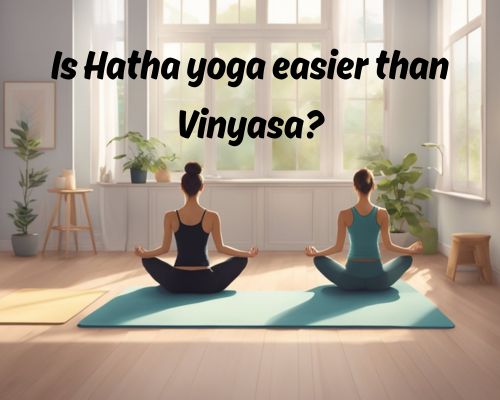
Yoga offers various styles, each tailored to different preferences and skill levels. Among these styles, Hatha and Vinyasa yoga are two popular choices for yoga enthusiasts.
Hatha yoga is generally considered easier for beginners due to its slower pace and focus on individual poses. This style provides an opportunity for newcomers to master the alignment and breathing necessary for a safe and effective practice.

While Hatha yoga is slower, Vinyasa yoga presents a dynamic flow, linking breath to movement and integrating poses in a more accelerated rhythm. This style can serve as both a cardiovascular and strength challenge, appealing to those looking to enhance physical endurance.
Vinyasa’s continuous movement may require a higher level of fitness and coordination, and it may be less accessible to those just beginning their yoga journey.
Yoga practitioners should choose based on their personal goals and physical conditions, see https://bikramyogamornington.com.au/.
For those seeking relaxation and gradual improvement, Hatha yoga may be more accommodating. Meanwhile, individuals interested in a vigorous, engaging experience might gravitate towards Vinyasa.
Each style holds its own benefits, allowing practitioners to explore and decide which suits their practice best.
Comparing Hatha and Vinyasa Yoga
Hatha and Vinyasa yoga are both popular styles with significant differences in their approach and benefits. While Hatha yoga focuses on alignment and holds poses longer, Vinyasa offers a dynamic flow with an emphasis on breath control and movement.
Core Differences
Hatha yoga can be seen as an umbrella term encompassing various practices, including Vinyasa. This style is characterised by its slower pace, allowing individuals to hold each posture for extended periods. It emphasises alignment and breathing techniques (Pranayama), making it accessible for beginners focusing on physical postures and foundational skills.
On the other hand, Vinyasa yoga is known for its fluid, faster sequences that link breath with movement, often described as a “flow.” It incorporates continuous transitions between poses, which can enhance cardiovascular health and build strength.
Vinyasa might be more challenging for beginners due to its pace, requiring greater breath control and physical fitness.
Physical and Mental Benefits
Hatha yoga’s mindful approach offers various benefits. The extended holds in Asanas promote flexibility, balance, and muscle strengthening.
This practice also supports relaxation, stress reduction, and improved mental health through meditation and mindfulness techniques. Focusing on alignment ensures the proper development of postures, enhancing the overall mind-body connection.
In contrast, Vinyasa yoga’s continuous movement keeps energy levels high and supports cardiovascular health. This dynamic practice enhances muscle strength and endurance while improving focus and flow.
Participants often experience stress relief and mental clarity, stemming from the combination of physical exertion and breath synchronisation.
Both styles contribute significantly to physical fitness and mental wellbeing but in uniquely different ways. Looking for a practitioner? See https://bikramyogamornington.com.au/.
Suitability for Practitioners
Beginners often find Hatha yoga more suitable due to its gentle pace and focus on foundational postures. It encourages listening to the body and adjusting poses for safety and comfort.
Those seeking an introduction to yoga or wishing to improve alignment, flexibility, and balance may find Hatha ideal for their needs.
Vinyasa yoga tends to suit those with prior yoga experience or a higher fitness level, as it demands both physical stamina and breath control.
Practitioners looking to enhance strength, cardiovascular health, and energy will benefit from the continuous, vigorous nature of Vinyasa.
Each style offers unique advantages, and choosing between them should depend on individual fitness goals and personal preferences.
Practice and Progression
Exploring the practice and progression of Hatha and Vinyasa yoga can help individuals align their discipline with personal wellness goals. Understanding the dynamics involved in poses, breath control, and emotional balance guides practitioners toward their desired outcomes.
Yoga Poses and Sequences
Hatha yoga emphasises holding poses for extended periods, promoting body awareness and flexibility.
It involves classical poses such as Mountain and Tree Pose, encouraging mindfulness and gradual mobility improvement.
Vinyasa yoga is characterised by its fluid sequences, often known as Vinyasa flows, connecting breath and movement through poses like Plank and Downward-Facing Dog.
This practice enhances core strength and energy flow by integrating physical activity with dynamic transitions.
Developing a Disciplined Practice
Establishing a disciplined practice requires commitment and structure.
Hatha yoga allows for gradual improvement in spiritual growth and relaxation through consistent practice. It supports emotional balance and promotes stress relief, often integrating meditation and breathing techniques.
Vinyasa yoga necessitates a regular routine due to its physical demands.
Developing a disciplined practice in Vinyasa involves embracing both challenge and recovery, enhancing wellness and endurance over time. Practitioners often explore different types of yoga, such as Ashtanga or Yin, to complement their practice.
Broadening Yoga Knowledge
Expanding one’s yoga knowledge enriches the practice experience. Knowledge of diverse types, like Raja Yoga or Restorative Yoga, builds a foundation for both personal development and potential yoga teacher training.
Understanding variations in styles enhances awareness of body mechanics and breathing techniques.
Hatha yoga practitioners often delve into the nuances of poses and meditation. Meanwhile, Vinyasa enthusiasts explore how sequences influence proprioception and energy flow.
Through this exploration, individuals cultivate a balanced and informed practice, harmoniously integrating mind, body, and spirit.


